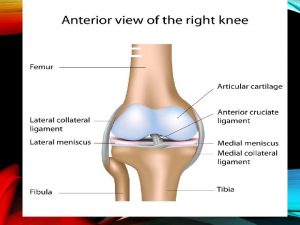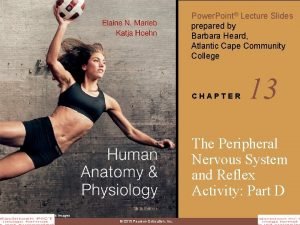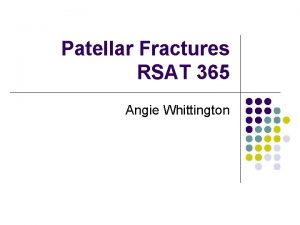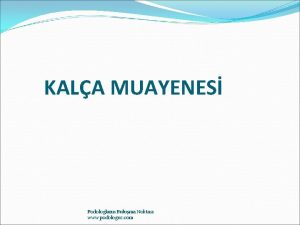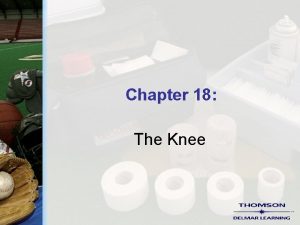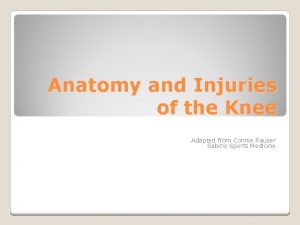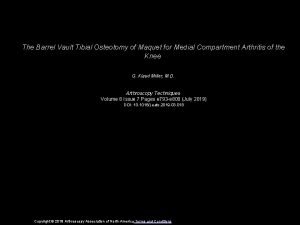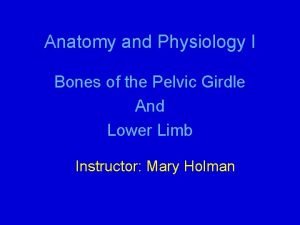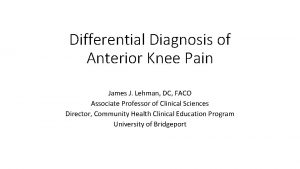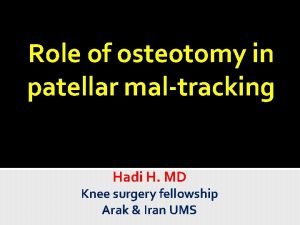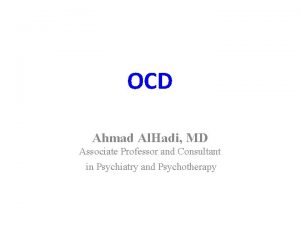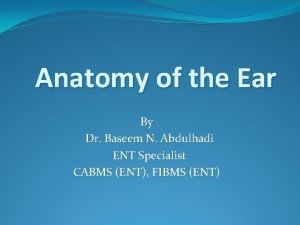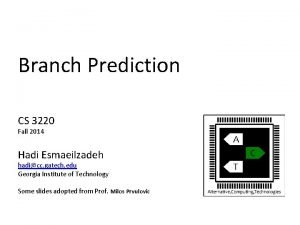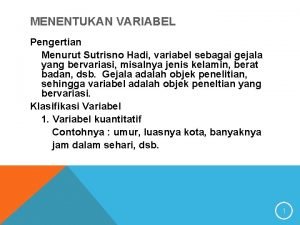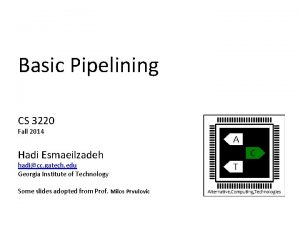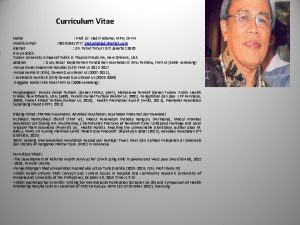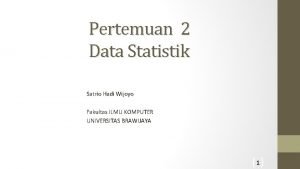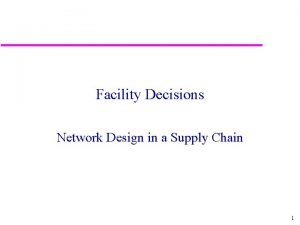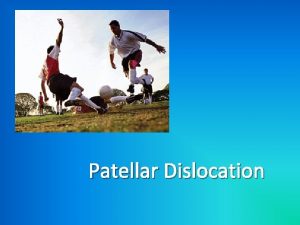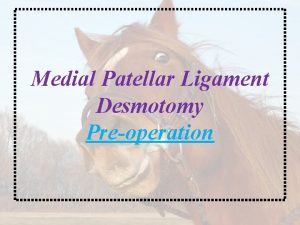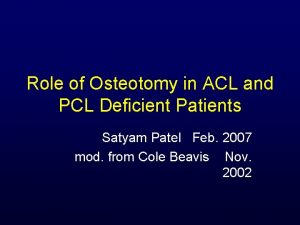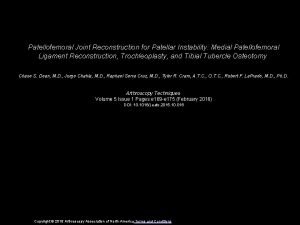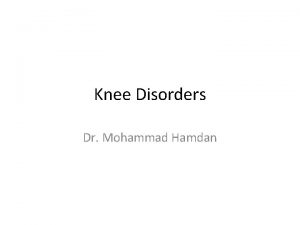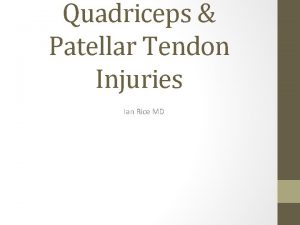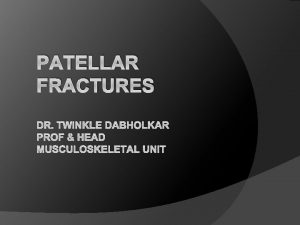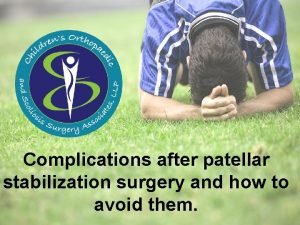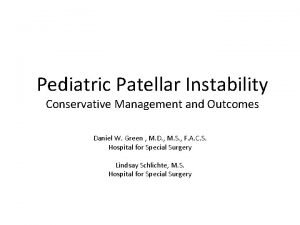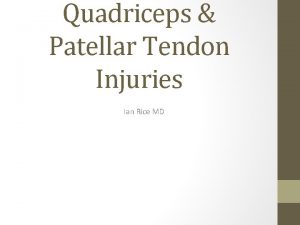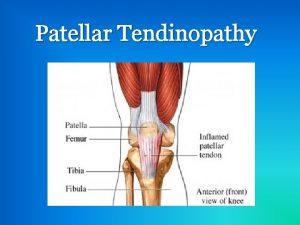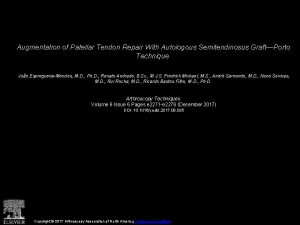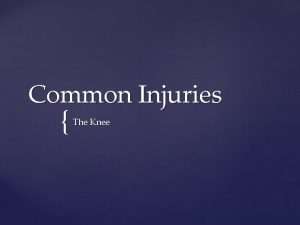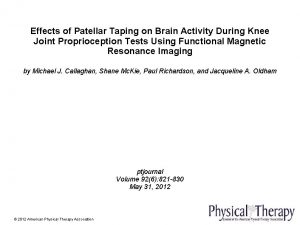Role of osteotomy in patellar maltracking Hadi H









































- Slides: 41

Role of osteotomy in patellar mal-tracking Hadi H. MD Knee surgery fellowship Arak & Iran UMS

Introduction Patellar mal-alignment may be defined as a �Translational or rotational deviation of the patella relative to any axis It is caused by an abnormal relationship between �Patella �Soft tissues surrounding the patella �Femoral and tibial osseous structures

Introduction Eckhoff stated that �‘‘the patella is a passive component of the extensor mechanism, where the static and dynamic relationships of the underlying tibia and femur determine the patellar tracking pattern’’ ü Eckhoff DG, (1997). Clin Orthop Relat Res

Introduction The source of such abnormal patellar kinematics may be �Peri-patellar tissue tightness or laxity �Osteo-chondral dysplasia (trochlear) �Bony abnormalities of the patella

Introduction The source of such abnormal patellar kinematics may be �Rotational mal-alignment of the femur and tibia �Patella alta and patella baja �Inflexibility or weakness of the quadriceps hamstrings, and iliotibial band (ITB), Achilles tendon

Introduction Well-known risk factors for symptomatic PF malalignment include �Genu valgum �Patella alta �Trochlea dysplasia �Increased TT- TG distance �Femur or tibia mal-rotation

Introduction The key to the indications for surgical treatment is �Diagnosis of the specific anatomic defects that cause the patient's symptoms �This underscores the importance of the history and physical examination �Abnormal findings are often quite subtle, leading to a major problem

Mal-alignment � Deviations in normal limb alignment � Knee joint flexion-extension axis advancing sideways � While the body moves forward

Mal-alignment These deviations include �Excess femoral anteversion or retroversion �Excess internal or external tibial torsion �Genu valgum or varum �Foot hyper-pronation �Achilles contracture

Rotational Mal-alignment Torsional deformities of the femur and/or tibia �Often go unrecognized in both adolescents and adults �Who present with anterior knee pain, and patellar mal-tracking and/or instability

Rotational Mal-alignment foot progression angle (FPA) �Averages 10° to 15° �Remains similar despite differences in the torsion of the tibia or femur �Hip rotation must vary if the torsion of the long bones changes and the FPA stays constant

Rotational Mal-alignment Constant foot progression angle (FPA) is likely because �Proper ankle dorsiflexion cannot occur during gait if the ankle joint axis is not aligned with the direction of forward movement �Most stable position of the foot on the ground

Rotational Mal-alignment If the knee joint twists inward because the femur twists inward � Lateral pull on the quadriceps � Lateral displacement pull on the patella � Strain on the medial MPFL Are increased

rotational Mal-alignment � A similar increase of inward pointing of the knee joint � Excess external tibial torsion when the foot is pointed forward

Rotational Mal-alignment �Compression on the lateral patellar facet is increased �Compression on the medial patellar facet is decreased

Rotational mal-alignment The clinical presentation may be �Pain �Instability �Arthrosis �Combination of these problems

Rotational mal-alignment � If this force is great � If the trochlear support is reduced � Medial ligaments may fail, resulting in lateral patellar instabil. Ity

Rotational mal-alignment � If the trochlear support is normal � The ligament may not fail but the articular load may increase, causing arthrosis � Pain in the medial retinaculum is a common symptom caused by this increased stress

Rotational mal-alignment � The dynamic picture is much worse � Ante-version puts the greater trochanter pointing posteriorly � So there is no hip abduction power and the pelvis collapses

Rotational mal-alignment � In an attempt to increase hip power and put the foot forward � The knee joint must point inward � Even more when there is an increase in hyper-pronation

Rotational mal-alignment Yoshioka and associates (1989, J. Orth. Rech. ) found in male & female �Identical femoral ante-version equal genu valgus �But an increase in external tibial torsion foot external rotation in females over males

Rotational mal-alignment This increase in external foot rotation may account for �The apparent increased genu valgus in females �The increased incidence in PF symptoms in females �Even the increased incidence of ACL tears in females

Rotational mal-alignment Biomechanical study that measured PF contact pressures concluded that �If an angular deformity and a torsional deformity coexist, the rotatory component causes the greater PF changes ü Fujikawa, K; Biomechanics of the patello-femoral joint. Eng Med , 1983

Mar-rotation Treatment �The goal of operative treatment is to normalize the biomechanics through restitution of normal anatomy �The morbidity of surgery may dictate otherwise �When multiple anatomic abnormalities exist, it is not known which may be more important

Indication Surgery is indicated �Torsion of the femur or tibia exceeding 30° from normal Surgery is beneficial �Torsion exceeding 20° from normal �Abnormality less than 20°, the accuracy of surgery or the morbidity may not justify the smaller biomechanical changes

Indication • Clinical symptoms with Angle > 2 SD on CT Scan • Rotational osteotomy

Tibial tubercle transfer (TTT) Distal realignment procedures modify the �Medial-lateral �Anterior-posterior �Proximal-distal positions of the patella by transfer of the tibial tubercle

Distal realignment (TTT) The primary contraindication �Absence of a distinct anatomic defect �Because the goal of surgery is to restore normal anatomy of the extensor mechanism

Distal realignment (TTT) A specific contraindication to extensor mechanism surgery is the presence of �Excessive hip anteversion or �Abnormal external tibial torsion �In these patients, a femoral or tibial derotation osteotomy may be indicated

Distal realignment Patella alta �Congenital abnormality �An increased vertical position of the patella �Due to an elongated patellar tendon �Patella not engaging within the trochlea until a mid -flexion range of motion �Patella instability or pain

Patella alta �Decrease in PF joint contact area at all knee flexion angles �Risk for early PF arthritis �In most patients, other abnormalities of the extensor mechanism are usually present

Patella alta Cartilage lesions typically �Infero-lateral portion of the lateral patella facet �Lateral region of the trochlea

Distal realignment (Distalization) Indications for surgery �Recurrent dislocations �Anterior knee pain that has not responded to conservative treatment

Distal realignment (Distalization) �Patient is advised that symptoms of anterior knee pain related to the arthritis will continue �It is thus preferable to correct a symptomatic patellar alta condition early prior to the development of cartilage deterioration

Distal realignment (Distalization) The goal � Restore a normal patellar height index � Patello-trochlear contact (~30% of the inferior patellar articular cartilage) has engaged the trochlear at full extension

Distal realignment (Distalization) When a distal transfer of the patellar tendon �Tenodesis of the tendon at the tibial insertion site would restore normal tendon length �Decrease side-to-side patellar mobility, given the high percentage of associated trochlear dysplasia

Distal realignment (AMZ) Indications (Fulkerson) �Patello-femoral pain �Either lateral or distal patellar arthrosis �Lateral subluxation/dislocations of the patella

Distal realignment (AMZ) The ideal candidate is someone with �Lateral patellar tilt (and/or subluxation) associated �With grade III or IV articular degeneration �Localized to the lateral and/or distal medial patellar facets

Distal realignment (AMZ) Contraindications �No mal-alignment �Occult medial patella subluxation �Diffuse patellar articular cartilage disease (especially at the proximal pole) �Mild articular changes (grade I or II) with tilt, and no subluxation ü May be better treated with an isolated lateral release

Conclusion In patella mal-tracking �Abnormal findings are often quite subtle, but combinations are surprisingly common �Torsional deformities are often unrecognized �For local cartilage lesions distal realignment may be appropriate �Exact pre-op planning is necessary for satisfactory outcome

Thanks for your attention
 Define deep tendon reflex
Define deep tendon reflex Patellar tendinitis moi
Patellar tendinitis moi Words using surgery
Words using surgery Muscle spindle
Muscle spindle Patellar fracture classification
Patellar fracture classification Faber testi
Faber testi Patellar dislocation
Patellar dislocation Sympathetic vs parasympathetic
Sympathetic vs parasympathetic Intracapsular extrasynovial meaning
Intracapsular extrasynovial meaning Trauners technique
Trauners technique Quadriceps knee flexion
Quadriceps knee flexion Predicime
Predicime Patellar surface
Patellar surface Osgood schlatter and patellar tendonitis
Osgood schlatter and patellar tendonitis Ustadz satria hadi lubis
Ustadz satria hadi lubis Perniagaan hadi
Perniagaan hadi Sayed hadi hashemi
Sayed hadi hashemi Dr nur mohammad hadi zahalan
Dr nur mohammad hadi zahalan Hadi mal
Hadi mal Hadi ahmad md
Hadi ahmad md Middle ear ossicles
Middle ear ossicles Good morning nice to see you
Good morning nice to see you Partograph
Partograph Hadi esmaeilzadeh
Hadi esmaeilzadeh Ruang lingkup penelitian pendidikan
Ruang lingkup penelitian pendidikan Kpmg taseer hadi & co
Kpmg taseer hadi & co Yulianto hadi
Yulianto hadi Pentingnya memahami variabel penelitian
Pentingnya memahami variabel penelitian Pipelinemx
Pipelinemx Prof hadi pratomo
Prof hadi pratomo Aglyfní
Aglyfní Contoh tabel klasifikasi
Contoh tabel klasifikasi Azure worker role
Azure worker role Symbolischer interaktionismus krappmann
Symbolischer interaktionismus krappmann Statuses and their related roles determine
Statuses and their related roles determine Role conflict
Role conflict Role of a teaching assistant
Role of a teaching assistant Toastmasters treasurer role
Toastmasters treasurer role Role of ifla
Role of ifla Network design decisions
Network design decisions Composition of cpcsea
Composition of cpcsea Role playing dimension power bi
Role playing dimension power bi

